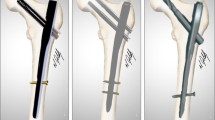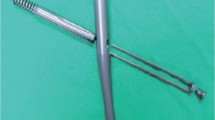Abstract
Background
Regarding trochanteric hip fractures, one type of posterior coronal fragments was described as the “banana-shaped fragment”, while the impact of the banana-shaped fragment on mechanical stability has not been further studied. The current study investigated the association between the banana-shaped fragment and mechanical complications after surgery.
Methods
This retrospective cohort study included 273 patients treated by proximal femoral nail antirotation (PFNA) in the full analysis. The age, the sex, the fracture side, the follow-up time, the American Society of Anesthesiologists classification, the operators, the fracture classification, the tip-apex distance, the blade positions, the reduction quality and the bone mineral density were analyzed in relation to mechanical complications, through univariate and multivariate approaches.
Results
Mechanical complications happened in 33 patients. The banana-shaped fragment (adjusted odds ratio 5.240, 95% CI 2.172 to 12.641; p < 0.001), the tip-apex distance and the reduction quality showed significant association with mechanical complications in both univariate and multivariate analysis. Moreover, for 118 patients with the banana-shaped fragment, we found that the use of wire cerclage couldn’t significantly lower the rates of mechanical complications (p = 0.648).
Conclusions
The banana-shaped fragment had a negative impact on mechanical stability of trochanteric hip fractures treated by PFNA. In the perioperative period, the BSF should be carefully evaluated, and its specific handling deserves further study.








Similar content being viewed by others
Data availability
The datasets used and/or analysed during the current study are available from the corresponding author on reasonable request.
References
Bhandari, M., & Swiontkowski, M. (2017). Management of acute hip fracture. The New England Journal of Medicine, 377, 2053–2062. https://doi.org/10.1056/NEJMcp1611090
Chang, S.-M., Hou, Z.-Y., Hu, S.-J., & Du, S.-C. (2020). Intertrochanteric femur fracture treatment in asia: what we know and what the world can learn. Orthopedic Clinics of North America, 51, 189–205. https://doi.org/10.1016/j.ocl.2019.11.011
Biber, R., Berger, J., & Bail, H. (2016). The art of trochanteric fracture reduction. Injury, 47(Suppl 7), S3–S6.
Futamura, K., et al. (2016). New classification focusing on the relationship between the attachment of the iliofemoral ligament and the course of the fracture line for intertrochanteric fractures. Injury, 47, 1685–1691. https://doi.org/10.1016/j.injury.2016.05.015
Cho, J. W., et al. (2017). Fracture morphology of AO/OTA 31-A trochanteric fractures: A 3D CT study with an emphasis on coronal fragments. Injury, 48, 277–284. https://doi.org/10.1016/j.injury.2016.12.015
Sharma, G., et al. (2017). Morphology of the posteromedial fragment in pertrochanteric fractures: A three-dimensional computed tomography analysis. Injury, 48, 419–431. https://doi.org/10.1016/j.injury.2016.11.010
Li, P., et al. (2020). Medial wall fragment involving large posterior cortex in pertrochanteric femur fractures: A notable preoperative risk factor for implant failure. Injury, 51, 683–687. https://doi.org/10.1016/j.injury.2020.01.019
Meinberg, E., Agel, J., Roberts, C., Karam, M., & Kellam, J. (2018). Fracture and dislocation classification compendium—2018. Journal of Orthopaedic Trauma, 32, S1–S10. https://doi.org/10.1097/bot.0000000000001063
Baumgaertner, M., Curtin, S., Lindskog, D., & Keggi, J. (1995). The value of the tip-apex distance in predicting failure of fixation of peritrochanteric fractures of the hip. Journal of Bone and Joint Surgery. American Volume, 77, 1058–1064.
Mao, W., et al. (2019). A novel angle on helical blade placement in trochanteric fractures—The axis-blade angle. Injury, 50, 1333–1338. https://doi.org/10.1016/j.injury.2019.05.006
Zhang, Y., Sun, Y., Liao, S., & Chang, S. (2020). Three-dimensional mapping of medial wall in unstable pertrochanteric fractures. BioMed Research International. https://doi.org/10.1155/2020/8428407
Li, M., et al. (2019). Three-dimensional mapping of intertrochanteric fracture lines. Chinese Medical Journal, 132, 2524–2533. https://doi.org/10.1097/cm9.0000000000000446
Cleveland, M., Bosworth, D., Thompson, F., Wilson, H., & Ishizuka, T. (1959). A ten-year analysis of intertrochanteric fractures of the femur. The Journal of Bone & Joint Surgery, 41, 1399–1408.
Chang, S., et al. (2015). Fracture reduction with positive medial cortical support: A key element in stability reconstruction for the unstable pertrochanteric hip fractures. Archives of Orthopaedic and Trauma Surgery, 135, 811–818.
Peyser, A., et al. (2007). A prospective, randomised study comparing the percutaneous compression plate and the compression hip screw for the treatment of intertrochanteric fractures of the hip. Journal of Bone and Joint Surgery. British Volume, 89, 1210–1217.
Jiamton, C., Boernert, K., Babst, R., Beeres, F., & Link, B. (2018). The nail-shaft-axis of the of proximal femoral nail antirotation (PFNA) is an important prognostic factor in the operative treatment of intertrochanteric fractures. Archives of Orthopaedic and Trauma Surgery, 138, 339–349.
Ippolito, E., et al. (2014). Radiographic classification of coronal plane femoral deformities in polyostotic fibrous dysplasia. Clinical Orthopaedics and Related Research, 472, 1558–1567.
Liu, W., Zhou, D., Liu, F., Weaver, M., & Vrahas, M. (2013). Mechanical complications of intertrochanteric hip fractures treated with trochanteric femoral nails. Journal of Trauma and Acute Care Surgery, 75, 304–310.
Choo, S. K., Oh, H. K., Ko, H. T., Min, D. U., & Kim, Y. (2017). Effectiveness of controlled telescoping system for lateral hip pain caused by sliding of blade following intramedullary nailing of trochanteric fracture. Injury, 48, 2201–2206. https://doi.org/10.1016/j.injury.2017.07.023
Landis, J. R., & Koch, G. G. (1977). The measurement of observer agreement for categorical data. Biometrics, 33, 159–174.
De Bruijn, K., den Hartog, D., Tuinebreijer, W., & Roukema, G. (2012). Reliability of predictors for screw cutout in intertrochanteric hip fractures. Journal of Bone and Joint Surgery. American Volume, 94, 1266–1272.
Mao, W., et al. (2019). Comparison of Baumgaertner and Chang reduction quality criteria for the assessment of trochanteric fractures. Bone & Joint Research, 8, 502–508. https://doi.org/10.1302/2046-3758.810.bjr-2019-0032.r1
Kaufer, H. (1980). Mechanics of the treatment of hip injuries. Clinical Orthopaedics and Related Research. https://doi.org/10.1097/00003086-198001000-00008
Tawari, A., Kempegowda, H., Suk, M., & Horwitz, D. (2015). What makes an intertrochanteric fracture unstable in 2015? Does the lateral wall play a role in the decision matrix? Journal of orthopaedic trauma. https://doi.org/10.1097/bot.0000000000000284
Haidukewych, G. J. (2009). Intertrochanteric fractures: Ten tips to improve results. Journal of Bone and Joint Surgery. American Volume, 91, 712–719.
Sun, Q., et al. (2018). The influence of position of the displaced lesser trochanter on clinical outcome of unstable trochanteric femur fractures in the elderly. BioMed Research International, 2018, 5013646. https://doi.org/10.1155/2018/5013646
Xiong, W. F., Zhang, Y. Q., Chang, S. M., Hu, S. J., & Du, S. C. (2019). Lesser trochanteric fragments in unstable pertrochanteric hip fractures: a morphological study using three-dimensional computed tomography (3-D CT) reconstruction. Medical Science Monitor : International Medical Journal of Experimental and Clinical Research, 25, 2049–2057. https://doi.org/10.12659/msm.913593
HIP Attack Investigators. (2020). Accelerated surgery versus standard care in hip fracture (HIP ATTACK): An international, randomised, controlled trial. The Lancet, 395, 698–708. https://doi.org/10.1016/S0140-6736(20)30058-1
Liu, X., Liu, Y., Pan, S., Cao, H., & Yu, D. (2015). Does integrity of the lesser trochanter influence the surgical outcome of intertrochanteric fracture in elderly patients? BMC Musculoskeletal Disorders, 16, 47. https://doi.org/10.1186/s12891-015-0492-7
Rehme, J., Woltmann, A., Brand, A., & von Rüden, C. (2021). Does auxiliary cerclage wiring provide intrinsic stability in cephalomedullary nailing of trochanteric and subtrochanteric fractures? International Orthopaedics, 45, 1329–1336. https://doi.org/10.1007/s00264-020-04795-4
Acknowledgements
The work was supported by the Project of the Shanghai Municipal Health Commission (Grant No. 20214Y0317).
Author information
Authors and Affiliations
Contributions
WM: the design of the work; analysis and interpretation of data; substantively revised it. AY: the acquisition, analysis of data; have drafted the work. SC: the conception; analysis of data; substantively revised it. YL: the analysis of data; the conception; substantively revised it. LL: the acquisition, analysis of data. HN: the acquisition, analysis of data. YD: the conception; the analysis of data; funding acquisition. All authors read and approved the final manuscript. WM, and AY contributed equally to this work. All authors have read and approved the final manuscript.
Corresponding author
Ethics declarations
Conflict of Interest
The authors declare that they have no competing interests.
Ethics approval and consent to participate
This cohort study was retrospectively registered by the Ethics Committee of the Shanghai Fifth People’s Hospital (2020EC171), with waiver of informed consent. This study was conducted in accordance with the relevant guidelines and regulations.
Informed consent
For this type of study informed consent is not required.
Additional information
Publisher's Note
Springer Nature remains neutral with regard to jurisdictional claims in published maps and institutional affiliations.
Rights and permissions
Springer Nature or its licensor (e.g. a society or other partner) holds exclusive rights to this article under a publishing agreement with the author(s) or other rightsholder(s); author self-archiving of the accepted manuscript version of this article is solely governed by the terms of such publishing agreement and applicable law.
About this article
Cite this article
Mao, W., Yang, Al., Chang, Sm. et al. The Impact of Banana-Shaped Fragments on Trochanteric Hip Fractures Treated by PFNA. JOIO 57, 1452–1460 (2023). https://doi.org/10.1007/s43465-023-00964-w
Received:
Accepted:
Published:
Issue Date:
DOI: https://doi.org/10.1007/s43465-023-00964-w




